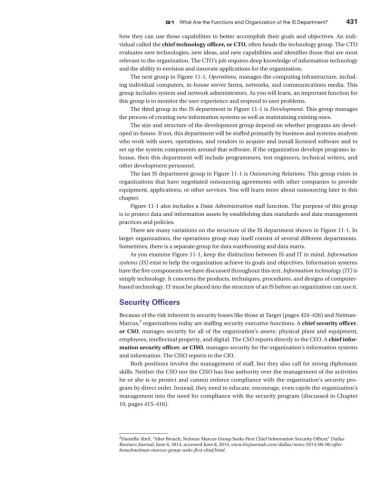Page 463 - Using MIS
P. 463
Q1 What Are the Functions and Organization of the IS Department? 431
how they can use those capabilities to better accomplish their goals and objectives. An indi-
vidual called the chief technology officer, or CTO, often heads the technology group. The CTO
evaluates new technologies, new ideas, and new capabilities and identifies those that are most
relevant to the organization. The CTO’s job requires deep knowledge of information technology
and the ability to envision and innovate applications for the organization.
The next group in Figure 11-1, Operations, manages the computing infrastructure, includ-
ing individual computers, in-house server farms, networks, and communications media. This
group includes system and network administrators. As you will learn, an important function for
this group is to monitor the user experience and respond to user problems.
The third group in the IS department in Figure 11-1 is Development. This group manages
the process of creating new information systems as well as maintaining existing ones.
The size and structure of the development group depend on whether programs are devel-
oped in-house. If not, this department will be staffed primarily by business and systems analysts
who work with users, operations, and vendors to acquire and install licensed software and to
set up the system components around that software. If the organization develops programs in-
house, then this department will include programmers, test engineers, technical writers, and
other development personnel.
The last IS department group in Figure 11-1 is Outsourcing Relations. This group exists in
organizations that have negotiated outsourcing agreements with other companies to provide
equipment, applications, or other services. You will learn more about outsourcing later in this
chapter.
Figure 11-1 also includes a Data Administration staff function. The purpose of this group
is to protect data and information assets by establishing data standards and data management
practices and policies.
There are many variations on the structure of the IS department shown in Figure 11-1. In
larger organizations, the operations group may itself consist of several different departments.
Sometimes, there is a separate group for data warehousing and data marts.
As you examine Figure 11-1, keep the distinction between IS and IT in mind. Information
systems (IS) exist to help the organization achieve its goals and objectives. Information systems
have the five components we have discussed throughout this text. Information technology (IT) is
simply technology. It concerns the products, techniques, procedures, and designs of computer-
based technology. IT must be placed into the structure of an IS before an organization can use it.
Security Officers
Because of the risk inherent in security losses like those at Target (pages 424–426) and Neiman-
2
Marcus, organizations today are staffing security executive functions. A chief security officer,
or CSO, manages security for all of the organization’s assets: physical plant and equipment,
employees, intellectual property, and digital. The CSO reports directly to the CEO. A chief infor-
mation security officer, or CISO, manages security for the organization’s information systems
and information. The CISO reports to the CIO.
Both positions involve the management of staff, but they also call for strong diplomatic
skills. Neither the CSO nor the CISO has line authority over the management of the activities
he or she is to protect and cannot enforce compliance with the organization’s security pro-
gram by direct order. Instead, they need to educate, encourage, even cajole the organization’s
management into the need for compliance with the security program (discussed in Chapter
10, pages 415–416).
2 Danielle Abril, “After Breach, Neiman Marcus Group Seeks First Chief Information Security Officer,” Dallas
Business Journal, June 6, 2014, accessed June 8, 2014, www.bizjournals.com/dallas/news/2014/06/06/after-
breachneiman-marcus-group-seeks-first-chief.html.

